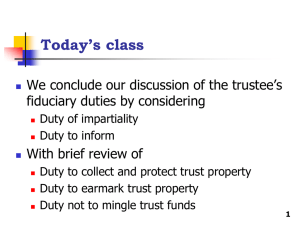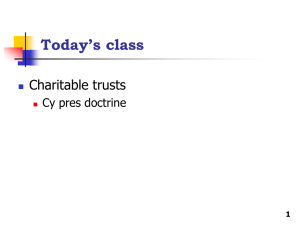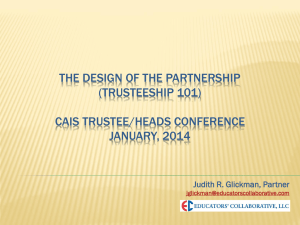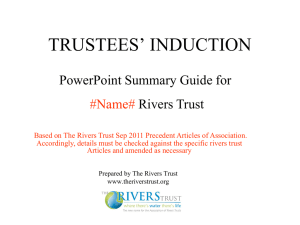Subrules Relating to the Trust Property
advertisement
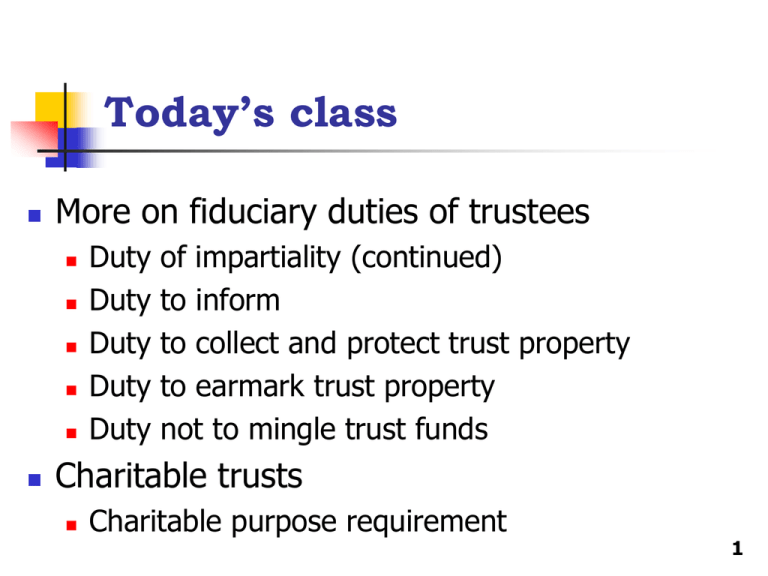
Today’s class More on fiduciary duties of trustees Duty Duty Duty Duty Duty of impartiality (continued) to inform to collect and protect trust property to earmark trust property not to mingle trust funds Charitable trusts Charitable purpose requirement 1 Uniform Principal and Income Act: Reallocation between income and principal Trust 1: $100,000 in bonds with a 4 percent interest rate. Each year, $4,000 in income is generated, and principal remains at $100,000. Trust 2: $100,000 in stock with an 8 percent appreciation but no dividends. Each year, the principal grows by $8,000 or more, but no income. If the trustee splits the increase in value in Trust 2 between income and principal, both income and principal beneficiaries are better off. (Income starts at $4,000, then $4,160, etc.) Ind. Code § 30-2-14 2 Uniform Principal and Income Act and the unitrust provisions The UPIA allows trustees to focus on total return without worrying whether the return takes the form of income or principal, but trustees still have to decide how much of the return to allocate to “income” and how much to “principal.” The unitrust provisions allow for a specified percentage of the trust’s assets to be treated as “income”—it can be a fixed percentage (4%), it can be tied to inflation, or it can be based on prevailing interest rates (and usually applied to a rolling three-year average of trust assets) When settlor chooses a unitrust, the settlor determines the percentage When trustees convert a trust to a unitrust, as in Heller, the statute sets the percentage (usually 3-5 percent) (3-5 percent in Indiana, with a presumption in favor of 4 percent, § 30-2-15-15). 3 Heller, p. 731 What were the facts? In his will, Jacob Heller created a trust (i.e., a testamentary trust). Jacob’s second wife, Bertha, would receive the total income from the trust each year, with an additional amount if needed to provide a minimum of $40,000 a year The remainder of the trust would be divided among Jacob’s four children from his first marriage After 15 years, the annual income from the trust had reached $190,000, and the trustees decided to elect New York’s unitrust provision (which would reduce Bertha’s 4 annual income to $70,000) In re Matter of Heller In re Matter of Heller 849 N.E.2d 262 (N.Y. 2007), p. 731 First Wife Jacob Remainder Alan Herbert Suzanne Bertha First Husband Income Faith Sandra 5 Why was it a problem for the trustees to elect unitrust conversion? In Heller, the trustees who elected the unitrust conversion also were remainder beneficiaries who would benefit from the reduced allocation of estate returns as “income” (from $190,000 to $70,000) The court rejected a no-further-inquiry standard for this structural conflict and instead required close scrutiny to ensure good faith and fairness by trustees NY did not prohibit unitrust conversions by conflicted trustees even though it did prohibit UPIA adjustments that would favor a trustee The trustees were meeting their fiduciary obligations to the other remainder beneficiaries In Indiana, trustees who are beneficiaries need court approval for a unitrust conversion (Ind. Code § 30-2-15-11) 6 Subrules relating to trust property, pp. 736-738 Duty to collect and protect trust property Trustee must collect and protect property without unnecessary delay (i.e., as promptly as circumstances permit). Precious jewelry or valuable art should be secured against theft and insured against loss Duty to earmark trust property Trustee must designate property as trust property rather than the trustee’s own (i.e., in the name of trustee as trustee) 7 Subrules relating to trust property, pp. 736-738 Duty not to mingle trust funds Trustees must keep trust funds in separate accounts But can make joint investments when pooling allows for better investing, as long as careful accounts are kept Duty not to mingle is especially strict with respect to the trustees’ personal funds Commingling is prohibited even if the trustees do not use the trust funds for their own purposes 8 UTC §813: Duty to inform and report, p. 738 (a) A trustee shall keep the qualified beneficiaries of the trust reasonably informed about the administration of the trust and of the material facts necessary for them to protect their interests. … (b) A trustee: (1) upon request of a beneficiary, shall promptly furnish…a copy of the trust instrument;… (3) … shall notify the qualified beneficiaries of the trust’s existence … . (c) A trustee shall send to the distributees…, and to other qualified or nonqualified beneficiaries who request it, at least annually … a report of the trust … . (d) A beneficiary may waive the right to a … report or other information … required to be furnished under this section. … 9 What were the facts? Fletcher v. Fletcher Fletcher v. Fletcher 480 S.E.2d 488 (Va. 1997), p. 739 Elinor placed all of her assets into a revocable, inter vivos trust and then amended it to provide for a number of separate trusts upon her death, including three for James, Andrew and Emily $50,000 to provide “adequate medical insurance and medical care.” $50,000 in such amounts as trustees deem advisable. Elinor J. North Henry James Andrew Emily $50,000 in such amounts as trustees deem advisable. 10 Fletcher As a beneficiary of Elinor’s trusts, was son, James, entitled to information only about his individual trust or about all of the trusts? That is, should the court treat the arrangement as a single trust or as many separate trusts? According to the court, James should be treated as a beneficiary of a single trust—there was a single trust agreement with multiple trust provisions rather than multiple trust agreements for the different trusts 11 Fletcher But James didn’t really need to see the entire trust agreement to monitor his own trust The court probably was sympathetic to James because he was Elinor’s son Even if James’ kinship motivated the court, the UTC codified the Fletcher holding with respect to all beneficiaries of a single trust agreement (§(b)(1)) Drafting lesson Elinor could have limited disclosure to James of the terms of his individual trust in the trust agreement, or she could have had multiple trust agreements 12 Charitable trusts v. private trusts, p.751 Private Trust Purpose Modification For the benefit of a an ascertainable beneficiary. Charitable Trust For the benefit of a charitable purpose. Claflin doctrine Deviation Beneficiaries Primary Enforcement Other Cy pres doctrine Deviation State Attorney General Exempt from RAP and certain taxes. 13 Charitable purpose Once you include “other purposes that are beneficial to the community,” it’s not difficult to create a valid charitable trust Nevertheless, if one isn’t careful, a court will conclude that a trust designed to be charitable fails as a private, benevolent trust. 14 Shenandoah Valley National Bank v. Taylor, Shenandoah Valley National Bank v. Taylor 63 S.E.2d 786 (Va. 1951), p. 752 What were the facts? (1) On the last school day of each calendar year before Easter my Trustee shall divide the net income into as many equal parts as there are children in the first, second and third grades of the John Kerr School … , and shall pay one of such equal parts to each child in such grades, to be used by such child in the furtherance of his or her obtainment of an education. Did the testator intend to create a charitable trust? What was the purported charitable purpose? 15 Why did the Henry trust fail? The court drew a distinction between charitable purposes and benevolent purposes and viewed the Henry trust as a benevolent trust If we have a benevolent purpose, then Henry created a private trust While he’s free to create a private trust, it would have to conform to the rule against perpetuities, and the Henry trust did not (pages 753-754) 16 Why did the Henry trust fail? Why didn’t the trust survive as a charitable trust for the advancement of education (pp. 754-755)? The distributions were to be made just before the Easter and Christmas holidays when the minds of the children “would be far removed from studies or other school activities.” This indicates that there was “no educational purpose . . . in the testator’s mind.” The trustee was required to distribute the income to the children and to all of the children without any control over the use of the funds once the children received them. The admonition to use the money for the obtainment of education “would be wholly impotent and of no avail” 17 Why did the Henry trust fail? Note the court’s rejection of the proposal to make the payments to guardians of the children That wouldn’t have solved the problem of testator intent—the goal of Henry was to bring to the children “happiness on the two holidays” (the Henry candy trust) (end of page 755) 18 Why did the Henry trust fail? What about the argument that giving all of the children semi-annual payments would provide a benefit to the community even without the educational provision (page 756, top)? The trust’s payments served a benevolent purpose. For financial enrichment to count as charitable, you need to give it to a class of poor or other needy persons (e.g., orphans in the Philippines). As the court wrote (middle, page 756) 19 Benevolent/charitable distinction, p. 757 It is not a charitable trust merely because it has a large class of indefinite beneficiaries. A charitable trust can exist even though it will benefit only one person. Business owners can set up charitable trusts for their needy employees but not for all of their employees. The costs-of-medical-school trust in Carlson . If Carlson had named the actual recipient, then it would have been a private trust. It was important that the trust would serve medical needs. The settlor does not have to determine the charitable purpose(s) of the trust but can leave that to the trustee. 20 Drafting lesson How might Henry have drafted his will to create a valid charitable trust? The trustees were to distribute the income to needy children The trustees were to deposit the income into college tuition accounts for the children The trustees were to make payments so the children could order books from the Scholastic book catalogue. In a state without a rule against perpetuities, the Henry trust would be acceptable as a private trust with ascertainable beneficiaries 21 UTC definitions “Beneficiary” means a person that (A) has a present or future beneficial interest in a trust, vested or contingent; or (B) in a capacity other than that of trustee, holds a power of appointment over trust property “Qualified beneficiary” means a beneficiary who, on the date the beneficiary’s qualification is determined: (A) is a distributee or permissible distributee of trust income or principal; (B) would be a distributee or permissible distributee of trust income or principal if the interests of the distributees described in subparagraph (A) terminated on that date without causing the trust to terminate; or (C) would be a distributee or permissible distributee of trust income or principal if the trust terminated on that date. 22 Charitable Purposes, p.751 Charitable trusts must have a charitable purpose. Indeed, if a trust is designed to provide for particular named people, it generally cannot be a charitable trust. Thus, for example, after the typhoon in the Philippines, you could set up a charitable trust for children left as orphans by the typhoon. But if you read about a family where the parents were killed, you could not set up a charitable trust for the five children. Note that it’s okay to have ascertainable beneficiaries in a charitable trust (e.g., orphans in Philippines or families of victims of the attack on the World Trade Center on 9/11). 23 Charitable Purposes, p.751 Charitable purposes include: (a) the relief of poverty; (b) the advancement of knowledge or education; (c) the advancement of religion; (d) the promotion of health; (e) governmental or municipal purposes; and (f) other purposes that are beneficial to the community. Restatement (Third) of Trusts §28 (2003) 24 Benevolent/charitable distinction “ . . . if a large sum of money is given in trust to apply the income each year in paying a certain sum to every inhabitant of a city, whether rich or poor, the trust is not charitable, since although each inhabitant may receive a benefit, the social interest of the community as such is not thereby promoted” (page 756) 25





